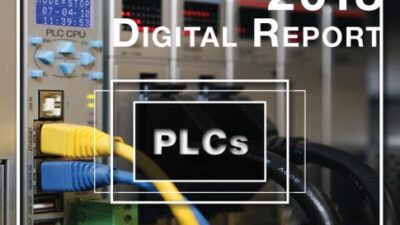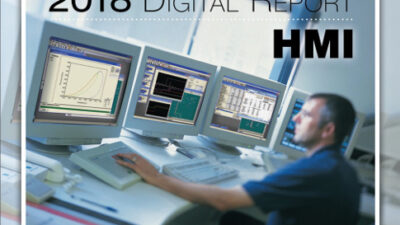It could be the temperature inside your enclosure.
|
A d/p cell shares an enclosure with Therm-Omega-Tech’s instrumentation thermostatically controlled heater (the flat coil) and TW/SC-A sensing valve (the black object above the coil). This steam-powered assembly keeps the temperature in the enclosure within |
I nstrument enclosures are commonly used to protect instrumentation against adverse weather conditions or physical damage and to ensure that the instrument operates at the proper temperature range. However, enclosures may not always provide sufficient protection against the temperature extremes that can affect instrument performance. Temperatures that are too high, for example, can cause some fluids to vaporize. And temperatures that are too low can cause some lines to freeze, or some products to thicken-even damaging sensitive equipment.
In many cases, the correct temperature of the instrument and sample will affect measurement accuracy. The best way to solve this problem is to equip enclosures with systems designed to maintain interior temperature within the range specified for optimal instrument performance.
Keeping it warm
The most common ways to keep enclosure temperatures warm involve either steam or electricity-essentially using an outside heat source to keep the equipment in the enclosure at a predetermined temperature.
Electrical heating can take several forms. Typically, a radiant heater or heating cable is installed inside the enclosure. A thermostat is used to control temperature or the cable can be self-limiting.
However, electrical heating has its limitations. In large installations, the electricity required can be a substantial expense. If combustible substances are present, there is also the risk posed by electrical sparks. And if the cable breaks, there could be even more trouble, since everything beyond the break would be subject to freezing.
In steam systems, small diameter copper or stainless steel tubing is ‘dressed’ around the inside of the enclosure, or a coil or finned-tubed heating element is installed within the enclosure. Steam, hot water, a heat transfer fluid, or even hot condensate is circulated through the tubing or heater, providing the heat needed to protect the instrumentation. Steam systems can provide excellent protection, but can also result in the instrumentation overheating, if not properly controlled.
Overheating can be avoided with systems that use self-contained, temperature-actuated valves to automatically control internal temperature of the enclosure. The most common installations consist of the following hardware.
-
A steam trap valve at the enclosure entrance that bleeds off any condensate that can form in the supply line, thereby keeping the line warm and ready to supply instant heat when the temperature control valve calls for it. It can also keep the steam supply line from freezing in cold weather when the steam to the box is turned off.
-
A temperature control valve that is designed to allow steam into the enclosure, should the temperature fall below a specified level. It’s a self-actuated valve containing a temperature-sensitive material that contracts when temperatures fall to a certain level, allowing the valve to open and steam to enter. As the temperature in the enclosure approaches the upper limit, the thermal material expands and closes the valve. In this way, the valve acts as a silent sentinel to ensure that the desired temperature within the enclosure is maintained.
-
A steam trap valve at the enclosure exit that drains condensate from the heater coil and provides back pressure in the heater.
Selecting steam tracing
Successful steam systems require valves of high durability and construction. Brass or stainless steel elements are highly desirable to prevent corrosion that can interfere with operation and shorten valve life. In addition, valves should have good ‘dirt handling’ capability. It also makes sense to select a valve from a company that produces it own actuators, instead of one that uses generic actuators produced by another supplier. Matched components usually provide more consistent quality and performance for the life of the installation. Actuators specifically designed for optimum performance can be produced to meet specific installation requirements.
Keeping it cool
Proper instrumentation performance also requires keeping the enclosure from getting too hot, whether the heat is generated by the equipment itself or by the process materials that are flowing through it. This is a significant problem when the internal temperature needs to be lower than the temperature outside. External heat sources, such as nearby hot process equipment or solar radiation, must also be taken into account.
Several design options can keep enclosure interiors cool. One of the most common is mechanical refrigeration, or air conditioning. Despite the fact that these systems can provide accurate temperature control, they can be expensive to install, maintain, and operate. They can be particularly expensive in plant areas requiring stringent electrical classifications, such as explosion-proof design.
Recirculating fluids, such as cooling water or glycol, can also be effectively used in enclosure cooling. However, as with refrigeration, these systems require installation of many mechanical components including recirculation loops, pumps, and heat exchangers. Maintenance of these systems can be high due to periodic checks for overall system function, coolant level, and specific gravity.
Into thin air
Another option for enclosure cooling is the use of compressed air. Compressed air has several advantages as a cooling medium. In facilities that have a compressed air system in place, no pump(s) is needed to deliver air to the enclosure and can eliminate the problem of system freeze-ups, if the air is kept dry. The temperature of the compressed air used can be reduced to well below its delivery temperature, even as low as -50 °F, if need be, using equipment such as a vortex device.
Vortex devices have no moving parts and require no power or signal connections. Compressed air is routed through the device, which then produces the temperature drop in the outlet air directed into the enclosure. As the cold air is being generated, a percentage of the inlet air is heated at the same time and must be discharged from the enclosure. These two air streams are referred to the ‘cold fraction’ and the ‘hot fraction,’ respectively. To maintain the cold air output, it is necessary to discharge some of the inlet air as the hot fraction.
If the equipment inside the enclosure needs to be warmer than the coldest air temperature coming out of the vortex, a conventional thermostat can be used to turn a solenoid valve on and off, as needed. In this case, however, electrical power would be required which would increase installed cost, especially in applications where code classifications require explosion-proof design.
Airflow to the vortex device can also be controlled by use of a self-operated temperature-actuated valve. Requiring no power or signal connections, use of this type of valve together with a vortex device, provides a completely self-powered, accurate, compressed air temperature control system.
The importance of temperature control cannot be overstated. Without it, the overall performance of the instrumentation within the enclosure may be in jeopardy. The key, then, is to install enclosure heating and/or cooling system as needed to safeguard the required performance and meet project cost objectives.
| Nick Tallos, vp of engineering for Therm-Omega-Tech (Warminster, Pa.), has 28 years experience in the specialty valve industry. He holds a BSME from Villanova University. E-mail Mr. Tallos at [email protected] . |


